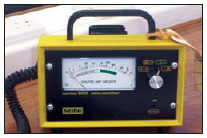Detecting Radiation
Although many radioactive materials are silver-colored, metallic solids in their pure state, they can vary in color and exist in different physical states, including liquids and gases. They are also physically indistinguishable from other (nonradioactive) metals. In addition, ionizing radiation is not detectable by one's senses. It cannot be seen, heard, smelled, tasted, or felt. For these reasons, simple visual inspection is insufficient to identify radioactive materials, and radiation sources can be virtually impossible to recognize without special markings. To address these problems, scientists have developed the following four major types of instruments to detect and identify radioactive materials and ionizing radiation:
- Personal Radiation Detector (PRD)
- Handheld Survey Meter
- Radiation Isotope Identification Device (RIID)
- Radiation Portal Monitor (RPM)
Personal Radiation Detector (PRD)
A PRD is a wearable gamma and/or neutron radiation detector, approximately the size of a pager. When exposed to elevated radiation levels, the device alarms with flashing lights, tones, and/or vibrations. Most PRDs numerically display the detected radiation intentisty (on a scale of 0 to 9) and, thus, can be used to locate a radiation source; however, they typically are not as sensitive as handheld survey meters and cannot identify the type of radioactive source.
Handheld Survey Meter
As the name implies, the survey meter is a handheld radiation detector, which typically measures the amount of radiation present and provides this information on a numerical display in units of counts per minute, counts per second, or microroentgen (µR) or microrem (µrem) per hour. Most of these devices detect beta and gamma radiation only. However, some models can detect alpha, beta, gamma, and/or neutron radiation emitted from radioactive materials.
 One particular meter, known as a teletector, is specifically designed to detect gamma and x-ray radiation. Named for its "telescoping" ability, this device can be extended to about 4 meters (13 feet) to measure very high dose rates without subjecting the user to unnecessary exposure. In addition, these devices typically have the ability to measure dose rates ranging from 0 to 1,000 rad per hour.
One particular meter, known as a teletector, is specifically designed to detect gamma and x-ray radiation. Named for its "telescoping" ability, this device can be extended to about 4 meters (13 feet) to measure very high dose rates without subjecting the user to unnecessary exposure. In addition, these devices typically have the ability to measure dose rates ranging from 0 to 1,000 rad per hour.
Radiation Isotope Identification Device (RIID
A RIID is a radiation detector with the ability to analyze the energy spectrum of radiation, in order to identify the specific radioactive material (radionuclide) that is emitting the radiation. In addition, these devices can be used as survey instruments to locate radioactive material.
Radiation Portal Monitor (RPM)
An RPM is a large pass-through radiation monitor (or "portal") for personnel, vehicles, container boxes, or trains. Typically, these devices consist of two pillars containing radiation detectors, which are remotely monitored from a display panel. These monitors alarm to indicate the presence of radioactive materials, including low-radiation materials like uranium.
Page Last Reviewed/Updated Friday, March 20, 2020
Page Last Reviewed/Updated Friday, March 20, 2020

